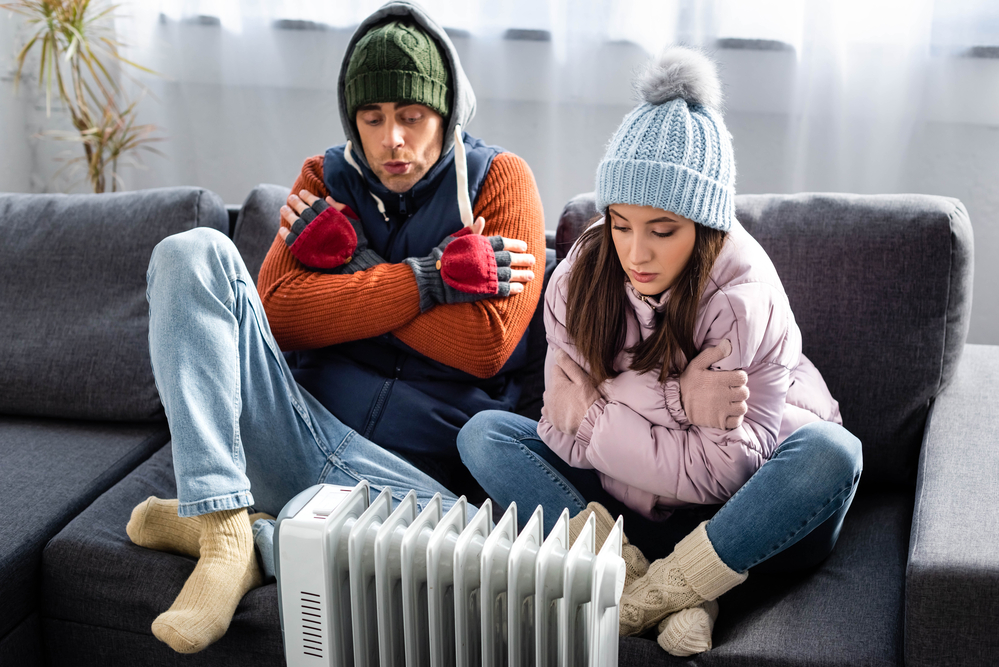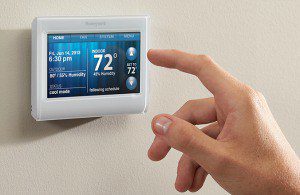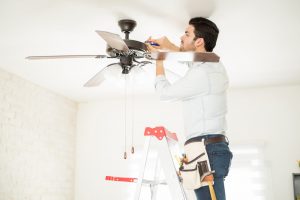
Keep your house cozy without breaking the bank this fall and winter.
Want to lower your energy costs? Of course, who doesn’t? We’ve pulled together a list of easy energy-saving ideas from simple tips where you’ll see a difference right away to energy-efficient home upgrades that pay off year over year.
According to Energy Star, in the average American household, almost half of the annual energy bill goes to heating and cooling – more than $900 a year. Following these money-saving tips can really add up and have a big impact on your family budget.
7 ways to lower your heating bill right now
- Open your curtains and blinds
- Check your insulation
- Seal your doors and windows
- Set your thermostat correctly for winter
- Create climate zones
- Run your ceiling fan clockwise in winter (really!)
- Upgrade to a high-efficient HVAC system
Take a closer look at our list and learn how you can put these ideas into practice in your home today.
- OPEN YOUR CURTAINS AND BLINDS

Even on the coldest days, direct sunlight will generate heat when it hits a window. So, on sunny days, let the sunshine in. Best of all – it’s free! Pro tip: open the blinds or curtains to let direct sunlight in and close them up once the sun moves away. Your blinds and curtains act as a secondary insulator and help keep cold air from seeping in.
- CHECK YOUR INSULATION
If your attic or crawlspace isn’t properly insulated, your heating system has to work harder to keep your home at a consistently comfortable temperature. The more it works, the more it costs you. Foam insulation can settle after a year. Homes built in the ’70s or earlier should be checked out as insulation quality has come a long way since then. If you live up north where it gets really cold, try adding extra insulation to the garage door, it can make a big difference.
- SEAL YOUR DOORS AND WINDOWS
You don’t need to be Mr. or Mrs. DIY to check the seals of your doors and windows and replace cracked or worn weather strips. Be sure to seal all cracks, holes, and gaps around windows to prevent air leaks.
- SET YOUR THERMOSTAT CORRECTLY FOR WINTER
- Okay, so there really isn’t one perfect temperature to keep your home during the winter. To get max efficiency out of your heating system all you have to do is use the built-in energy-saving functionality most of today’s thermostats have.
- Programmable thermostats.

Programmable thermostats allow you to set a variety of temperature preferences during the day for each day of the week. A good guideline for winter is to set it to about 68 degrees Fahrenheit (20 degrees Celsius) when you’re home and lower it (about 10-12 degrees Fahrenheit or 6-8 degrees Celsius) at night or when you’re away. As great as programmable thermostats are – they only work if you use them properly. If you constantly adjust the temperature – you’ll end up spending more, not less, on your energy bill. - Smart thermostats. If you haven’t already, consider upgrading to a connected, smart home thermostat. Truth is, even though they can, most people don’t use their programmable thermostat properly. Smart thermostats take the human element out of it. These next-gen thermostats do more than just keep your home warm and cozy all winter (which they do very well), they learn your patterns and automatically adjust the temperature for max efficiency and energy savings.
- You can program them remotely, get real-time performance alerts and even hide that digital display with a screensaver of your choice. When connected, you can control lights, locks, and several other smart home appliances. Check out the Trane ComfortLink™ II XL1050 or ask your local Trane dealer to recommend the best thermostat for your home.
- CREATE CLIMATE ZONES
 The idea here is simple: direct more warm air to the rooms you use most. The DIY way to do this is to close the vents in the rooms you don’t use often. This forces your heating system to direct more warm air to where you want it. Take this concept to the next level by having an HVAC professional install a climate zone system, like the Trane ComfortLink™ II Zoning System. Trane uses exclusive motorized modulating dampers inside your ductwork to open and close in partial increments. This means heated or cooled air is directed where it’s needed, providing maximum comfort where you want it most.
The idea here is simple: direct more warm air to the rooms you use most. The DIY way to do this is to close the vents in the rooms you don’t use often. This forces your heating system to direct more warm air to where you want it. Take this concept to the next level by having an HVAC professional install a climate zone system, like the Trane ComfortLink™ II Zoning System. Trane uses exclusive motorized modulating dampers inside your ductwork to open and close in partial increments. This means heated or cooled air is directed where it’s needed, providing maximum comfort where you want it most.
6. RUN YOUR CEILING FAN CLOCKWISE IN WINTER (REALLY!)
Fans aren’t just for keeping you cool in the summer. Ceiling fans do a great job of circulating warm air that rises to the top of the room and distributing it throughout the house.
- UPGRADE TO A HIGH-EFFICIENT HVAC SYSTEM
If your home heating and cooling system are over ten years old, it’s not going to have the energy-efficient SEER rating that is now standard. Most of the systems that are installed prior to 2006 are 10 SEER or lower. You can save up to 62% in energy costs with a more efficient system. Talk to a Trane Comfort Specialist about upgrading to an ultra-efficient Trane today.
One final thought
Your home heating and cooling system is a large portion of your home energy budget. If you want to really understand your home energy use – and get custom energy-saving solutions, talk to your local Trane Comfort Specialist and schedule an in-home energy evaluation. 
For 24/7 residential or commercial HVAC emergency repair & replacement, or for an estimate, contact us today at 763-565-2121.
*Re-posted by: https://www.trane.com/residential/en/resources/7-ways-to-lower-your-heating-bill/
